Over the past 10 years one of the most effective ways to generate leads has been to offer prospective buyers “premium content” in exchange for their content details. Most buyers are willing to fill out a gated form with their name and email address in exchange for access to re-playable webinars, white papers, sponsored research and e-books. But over the past 12 months I have observed a growing number of companies using an expanded set of downloadable content pieces (which are being called “apps”) to generate the same result.
The term “app” is probably one of the most over-used words in the technology profession so let me explain what I mean. Also, let me clarify that this is not my term, but one I picked up from other marketing professionals. In this case, I am not referring to apps that you would run on your mobile device or apps you would sell in an online marketplace. Instead, I am referring to job aids created in spreadsheet, document or presentation format that prospective buyers can download to use on their PC (or Mac). Examples of apps might include scorecards, calculators, checklists or cheat sheets. Templates are another popular type of downloadable app. You might offer templates for goal-setting, budget estimating, project planning, work scheduling, executive presentations or competitive assessments.
Still confused? Let’s look at a few examples from two companies that I think do this extraordinarily well. The first is Hubspot (no surprise)
- Cheat sheets for mastering Twitter, Facebook, LinkedIn and Google+
- Checklists for selling and marketing iPad apps and for rolling a new website design
- Template for identifying 2013 marketing goals
- Editorial calendar templates for creating blog content
- Worksheets for managing and organizing your Google AdWords campaigns
- Calculators for determining your sales and marketing lead generation goals
In the past six months Hubspot has expanded beyond just job aids to new tools that allow amateurs to create near-professional looking marketing deliverables. For example, Hubspot introduced apps that allow users to easily create infographics and ebooks using the basic functions of Microsoft PowerPoint.
Sample Downloadable App from Sales Benchmark Index
There are a few distinct differences between these “apps” and the traditional lead generation pieces such as white papers and webinars.
First, these apps are not static. They are interactive. We are witnessing a paradigm shift in downloadable content much like the change that occurred between Web 1.0 to Web 2.0. Unlike a white paper or e-book whose content is locked down these apps allow users to input their own content into a calculator, calendar or project plan. Furthermore, the user can modify the apps as they see fit. They can change the formulas used in calculations; adjust the timeframes in calendars; or modify the color pallet in presentations. Users can add more functionality to an app if they prefer or scale down the capabilities after downloading.
Second, these apps are not created in an intimidating and expensive Adobe Suite product that requires six months of training to use. These apps are built using the Microsoft Office Suite – Word, PowerPoint, Excel, Visio and Project. As a result the apps can be created by mere mortals in as short as a few hours. The shortening of the timeframe to develop is important, but the cost avoidance achieved by not having to use an outside agency or freelance professional is even more compelling.
Sales Benchmark Index offers another great example of a company that creates downloadable apps.
If you are not familiar with SBI you should be. They publish a daily blog that targets different buyer personas in sales and marketing roles. At the end of almost every blog is a call-to-action that encourages the reader to download a related job aid. Examples include:
- Assessment tools to benchmark your team against world-class marketing organizations
- Calculators to determine the number of sales representatives you need to meet quota
- Guides to help sales representatives prepare for a job interview at a top firm
- Worksheets to estimate the number of leads required to meet your pipeline targets
- Presentations template that outlines the best approach to pitching an idea to an executive team
The pace and quality of the SBI content is amazing, but there is one other facet of their approach I find fascinating. SBI does not target static buyer personas. Instead, they produce content that transcends a reader’s current title and organization. In fact, some of SBI’s best articles are targeted towards readers that are aspiring to switch jobs or to be promoted, which demonstrates how well they understand the persona of a highly motivated sales or marketing professional.
This post would have a lot more credibility if I had a call to action and a downloadable app to offer you. But since I’m not trying to sell anything or generate any leads from this blog I am hoping you will give me a pass.











One Comment